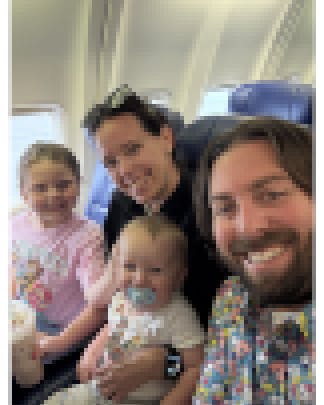Hayley Leibson, a mother from Mill Valley, a wealthy area just north of San Francisco, started hunting for a language-immersion child care program when her son was 8 months old.
“I thought I was really early,” Leibson says, noting that her son wasn’t going to attend until he turned 2. Some schools laughed her out of the room, telling her that other families applied as soon as they became pregnant.
Transitional kindergarten, a public early education program for 4-year-olds in California that provides a structured bridge between preschool and kindergarten, had been cut from her region for the 2025-2026 school year. Leibson says she felt the cut put extra pressure on her to find a private option.
But right away she noticed that the application process presented what she thought were ludicrous hurdles. Schools asked Leibson to write essays about her son’s “learning style” — before he could even talk — and demanded specific details about Leibson’s connection to families already attending those programs, such as listing out the last time she saw them and what they did together.
Mostly, Leibson spent a lot of time vetting programs. Meetings occurred when it was convenient for the care providers, meaning Leibson had to rearrange her own work schedule. Before inspecting a program, Leibson found it nearly impossible to discern whether the school seemed to her like a money-grab that didn’t care much about the kids. Options with rave reviews on Google would be run-down when she visited.
“It was like a part-time job — very time-consuming and hard,” she says.
It helped her to chat with teachers and other parents, who warned her of pest problems and other issues. “The most valuable are people who don't go [to a school] anymore,” she adds.
After going through all that, programs would reject her son because he had difficulty napping or because of rules about potty training she considered wacky. When offers came in, providers would “explode” if Leibson didn’t accept within a short period of time, sometimes as brief as 24 hours.
So eventually, Leibson turned to a “navigator,” an edtech tool that helps parents sort through early education options. The tool lists parent reviews of schools and relevant information including how much the programs cost, streamlining the search process and providing more finely tuned information than Google. Leibson finally found child care. By that time, the whole process had dragged on for months.
Soon, that arduous experience might also become the norm for families trying to pick a primary or secondary school.
Driven by the rise of school vouchers, the company behind the navigator recently moved into K-12 education, in an attempt to build a “comprehensive” tool for parents struggling to figure out how to choose a school for their child. Indeed, there are a growing number of companies trying to help parents handle K-12 school options, according to Matthew Tower, vice president of strategy and research for Whiteboard Advisors, an education consultancy and advocacy firm.
Company leaders believe that what has helped mothers like Leibson navigate the confusion of finding child care and preschools in a country that lacks a robust public early education system could provide families a workable way to manage private school options for older kids, too, which suffer some of the same problems.
But other experts aren’t so sure, arguing that it might mask the issues with the emergent school choice system.

Struggling With Choice
When Donald Trump entered his second term as president, he boosted the “school choice” movement. Already making headway across the country, the system has reached new major milestones this year, such as when Texas signed a $1 billion voucher system into law at the beginning of May. And the GOP’s One Big Beautiful Bill Act, signed into law on July 4, includes a national school voucher plan, setting up scholarships for families to attend private schools around the country, which opponents term a “tax shelter” for wealthy private school supporters. States will have to opt in due to a last-minute change to the bill.
At the state level, these voucher systems divert money from public schools for parents to use on private school tuition, fees or related expenses. The systems are controversial, and a number of states have resisted them. Supporters claim they enhance parents' choices, thereby improving educational quality. But opponents counter that they starve public schools of money and lower the quality of education in the country, also often pointing to the use of this system to evade school integration in Southern states after the 1954 Supreme Court decision in Brown v. Board of Education. These days, private schools retain greater leeway in turning away students, and they have weaker legal requirements for dealing with students with disabilities. Critics also point to some research that suggests vouchers are associated with a decline in student performance for low-income students.
The early childhood market is distinct from these K-12 options — for instance, early childhood is more fragmented, and chronically underfunded, according to David Blau, a labor and population economist and a professor emeritus at Ohio State University.
But there are some parallels between the child care subsidy system — which offsets the costs of programs that families in some states choose for their young children — and these new K-12 vouchers. For example, they have both proved thorny tangles for families, who have difficulty assessing quality of programs or making meaningful choices because there’s little accurate, accessible data about student academic outcomes at different institutions. They also lack adequate regulations, according to some researchers.
The similarities are at least strong enough that one edtech company says it can help parents across both markets.
Winnie, the child care marketplace navigator that Leibson used to find a preschool, expanded into K-12 schools this year. The company is trying to give parents a comprehensive search-and-filter tool for public, charter and private schools, says CEO Sara Mauskopf. The lines between early learning and K-12 schooling have blurred, with an uptick in the number of children attending independent schools from a younger age, Mauskopf says.
Now, the company has noticed a shift in what parents are searching for on its marketplace. These days, about 20 percent of parents on Winnie are exploring choices for children over the age of 5, according to Mauskopf. She attributes this largely to the rise of options. That includes school vouchers, which create a new incentive for families to shop around among charter and private schools rather than automatically enroll children in their assigned district public school. Mauskopf says that public charter schools also market heavily to families.
This new behavior is pushing Winnie further into the K-12 space. Mauskopf expects that the number of schools marketing directly to parents will only increase.
'Smoke and Mirrors'
While marketplace navigators are relatively common in early childhood education, they are unusual in K-12, according to researchers. Mauskopf views her main competition as sites like Yelp or Google, to which some parents turn for information about prospective schools or child care options.
But some experts warn that this expanded approach is a cause for concern.
Cramming the disparate education systems together for parents in one tool can conceal meaningful differences, such as the fact that the child care world lacks a strong public system, unlike in K-12, as most students in the country already attend public elementary, middle and high schools, says Paige Shoemaker DeMio, a senior policy analyst for K-12 at the Center for American Progress (CAP).
The navigator doesn’t have transparent student performance data that would clarify which options are high quality, and yet parents will be likely to trust that school options listed on the app are good ones, according to CAP researchers. And the results families see when they use the tool are not totally objective, because schools can influence their profiles. Schools listed on the site can claim their page to update information and receive inquiries from parents. When a school changes its description, a disclaimer is added, according to Mauskopf.
The company also offers schools a service called Winnie Pro that boosts their listing in parents’ search results, and which allows schools to customize their listing on the site and track their performance more closely. For any given parent’s search, how many sponsored pages appear depends on the specifics of the search, and it rotates based on how many parent leads Winnie has already sent the school so far that month, Mauskopf says.
If the school voucher movement succeeds in directing more families away from public schools and toward charter or private schools, parents may indeed appreciate help making choices, perhaps through these kinds of tools. But giving parents a navigator doesn’t really solve the core issues that arise from having to choose among private and charter child care programs and schools, Shoemaker DeMio says, such as tuition prices that are too high to afford, admission policies that exclude students with disabilities or secretive practices that obscure data about how much students are learning.
By creating the illusion of transparency and accessibility, navigation tools may make it more difficult for families to actually exercise meaningful choices about education — making it all “smoke and mirrors,” Shoemaker DeMio argues.
What do families think — will they use the navigator for K-12 charter and private schools?
Some are.
Shannon Parola, a mother from El Dorado County, near Sacramento, struggled to adjust to a transitional kindergarten for her asthmatic daughter.
The family had moved from the Bay Area, where Parola had worked as a nanny. After the move, Parola used Winnie to find a private child care program that worked well.
But not long after, the family had a second child on the way. And with rising child care costs, they decided to “rip the Band-Aid off,” moving their daughter to the public transitional kindergarten program just down the street from where they lived, in the same elementary school zoned for their house.
When Parola got her daughter’s first report card back, it startled her. It was only October, and yet the report card indicated there was nowhere for her daughter to improve, Parola says. She was already meeting their standards, Parola recalls. Still, the school wouldn’t bump her daughter to kindergarten, citing a lack of room. Parola, who volunteered in her daughter’s classroom, noticed her complaining of boredom. She worried that the cycle would repeat itself the next year. So, the family moved her to a charter homeschool program.
They pay “out the butt” for the program, she says. But she’s happy with how it worked out, she adds: “We wanted the best for our daughter.”

She’s less happy with how long the process took.
To find the program, Parola tried Greatschools.com, a nonprofit rating system for schools, also used by realty companies like Zillow for third-party evaluations of public schools. But Parola says the ratings weren’t terribly reliable or hadn’t been updated in a long time, meaning she had to cross-reference information with local moms on Facebook.
That was before Winnie’s K-12 search, and the process dragged on for an entire year, Parola says. Without a one-stop shop for evaluating all the possibilities available to her — public, charter, private and homeschool options — Parola felt as if she was being denied the information that would have allowed her to make a truly informed choice.
Now Parola, who runs a child care coaching business, recommends the navigator service to other parents. She’s also used it for more recent searches, including for finding summer care and camps. That’s because it lists all the options — including ones that are tough to find through Google reviews — while also capturing information about licensing and safety measures, Parola says.
Mauskopf says that demand is driving the company’s expansion, showing that families are using the marketplace tool to wade through the sea of private and charter K-12 options in front of them.
Certainly, when talking to other parents, Parola can feel the strain making these choices puts on them.
“I think parents are just so overwhelmed, not only with choices [but] with life and everything,” she says. “If you talk about, ‘Oh, now I’ve got to learn a whole process of how to find my kid’s school, how to find child care,’ it sends them down into a deep spiral.”


